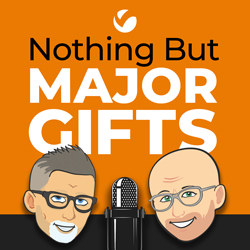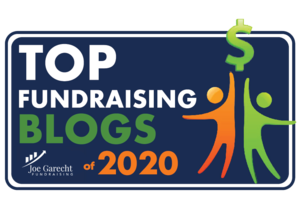To be blunt, the metrics used to evaluate many major gift programs these days don’t make much sense to Richard and me, especially the metrics around how many face-to-face meetings or phone calls you need to make every month with the donors in your portfolio.
We find too many MGOs who get so focused on meeting a metric, they lose their heads on what they’re really trying to accomplish: establishing a meaningful relationship with a donor so you can understand the donor’s passions and interests, which will allow you to inspire them to support specific programs and projects your organization is using to address problems in the world around you.
We’ve seen it happen where a major gift fundraiser is in the last week of the month, and they’re way behind in meeting their face-to-face or “donor contact” metric, so they set up a bunch of meetings or make a bunch of calls so they can meet their quota for the month.
Instead, let’s throw that old paradigm out the window and embrace the concept of creating “meaningful connections.” A meaningful connection is one where you take an action with a donor that moves the donor to a deeper relationship with you and the organization, and/or helps you understand the donor more, so you know how a gift can help the donor find joy in their life.
That meaningful connection can be made any number of ways: a personal visit, a phone call, an email, a handwritten note, a formal proposal, or through a personal touch of another sort. The point is, it’s done with preparation and intentionality.
I saw a good article on McKinsey.com about what makes a good meeting. As I was reading it, I thought it could translate well into preparing and really thinking about making a meaningful connection with your major donors. In the article by Aaron De Smet, Gregor Jost, and Leigh Weiss, they highlight three things you should ask yourself before you consider setting up a meeting.
I’m going to take some creative license to fit your situation as a major gift officer; but these three questions will help you create a meaningful connection with your donors and move the relationship forward.
- Should I even connect with the donor right now? In other words, do you have a good reason to meet with, call or email your donor? Have you spent time thinking about what the objective would be?
- What is it you’re trying to do with the donor? Many times you feel pressured to “get a meeting with a donor,” and without thinking you set something up and you scramble to figure out what you actually want to accomplish. Richard and I have seen cases where a major gift officer won’t spend enough time figuring this out, and they use the meeting to ask the donor for a large gift, and both the major gift officer and the donor aren’t ready for that ask. The key is to think about where you’re taking the relationship with the donor, what you need to know about the donor – and then in that context figure out what type of connection you want to create, and the objective of that connection should be. Too many times you’re not preparing enough with the donor. Spend time figuring this out prior to that face-to-face meeting or phone call, and how it fits into the overall objective of building that relationship – this is crucial.
- What is everyone’s role? This is especially important when you’re meeting face-to-face with a donor or on the phone, and you’ve invited someone else with your organization to interact with the donor. That could be the CEO, or a program officer or even a finance person. Figuring out what your role will be, and everyone else’s role on the call, is very important. Richard and I have seen situations where it’s not clear what everyone’s role is, and the donor leaves confused and concerned that the non-profit doesn’t have its act together. But even if you’re the only one connecting to the donor, figure out what your main role is in that meeting. Facilitator? Interviewer? Listener? The point is to prepare thoughtfully.
Creating meaningful connections with your donor takes work. It takes planning and preparation, which will make it meaningful. Making it meaningful will move the relationship deeper, which will make it easier to understand and know that donor. That helps you to inspire the donor with offers that will fulfill their passion and interests.
Ultimately, this will lead you to make (or exceed!) the ultimate metric of meeting your individual donor revenue goals for the year. Meaningful connections: take the proper time and attention for it, and you’ll see amazing results.
Jeff







I wish these posts were easier to print. So much important information. You are my favorite email to receive.